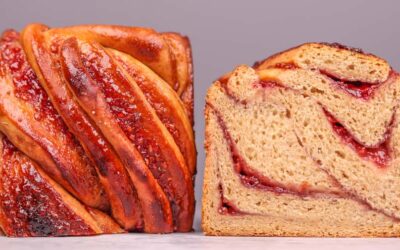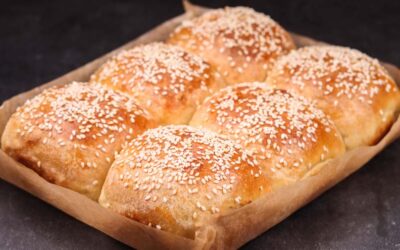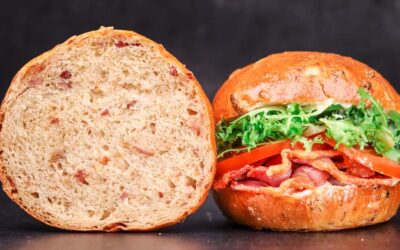Call it what you want – it is the bread with the crunchiest crust ever.
Dutch crunch bread originated in the Netherlands as the name suggests. There are various versions of this bread. It can be a super soft white loaf or individual little buns, or even long shaped sub rolls. There are also whole wheat ones.
My recipe aims for the most contrast – extremely soft interior vs super crunchy crust. It is also very convenient as you could make this bread in around 4 hours from the time you mix the dough to the minute you pull it out of the oven.
If you have watched my glaze comparison video in which I compared 15 most used glazes in breadmaking you may remember that I made a glaze out of rye bread dough. The principle here is the same.
The topping is made of rice flour, water, yeast, salt, oil, and sugar. It is fermented and then brushed on the dough before final proofing. Both the dough and the topping rise and expand. As the dough rises and expands it creates those signature cracks in the topping and the fermented topping becomes airy and thus crunchy later when baked.
It is a bread like no other. I have never come across such a unique texture. The crunchy crust is not hard at all. It breaks up and crumbles perfectly as you eat it. And the flavour is unique too. Toasty goodness!
Some recipes suggest using toasted sesame oil for the topping. That would intensify the flavour even more.
You must use rice flour. Not ground rice powder or regular flour or starch. It must be rice flour to achieve the correct texture. I have tried it with other flours and starches. So far only the rice flour has worked.
You can shape this dough however you like. Make 6 – 8 rolls out of it or make longer baguette shaped breads. Bake it as a free-standing loaf if you do not have a tin.
Watch the video down below for detailed instructions.
Ingredients
For the dough –
450g (15.9oz) white bread flour
215g (7.6oz) cool water*
7g (0.25oz) instant dry yeast or 8.4g (0.3oz) active dry yeast or 21g (0.74oz) fresh yeast
9g (0.31oz) salt
15g (0.52oz) sugar
40g (1.4oz) soft butter
1 egg, around 50g (1.75oz)
*To learn more about dough temperature control click here.
The four I use has a protein content of 13%. If your flour is weaker, then you may need to lower the hydration.
If you are using active dry yeast, then you may need to let it sit in the water for 10 minutes before adding the other ingredients or else it could take a lot longer to raise the dough.
For the topping –
35g (1.25oz) rice flour
35g (1.25oz) water
1g (0.035oz) salt
5g (0.17oz) sugar
2g (0.07oz) yeast
10g (0.35oz) oil
Method
- In a large bowl combine the water, egg, yeast, salt, sugar, and butter. Mix well to dissolve the salt and sugar, and to hydrate the yeast.
- Add the flour and mix to a dough. Tip the dough out on the table and knead for 7 minutes. *Desired dough temperature 25C (77F). If your dough is warmer, then it will ferment more rapidly. If it is cooler, then it will take longer. Adjust proofing time accordingly.
- Cover and ferment for 1 hour.
- Fold. Mix the topping at this point.
- Ferment for 1 hour.
- Pre-shape and leave to rest for 20 minutes.
- Shape and place in a 2lb (900g) loaf tin. Brush with the topping. Use all of it.
- Final proof 1 hour. *During this time preheat your oven to 160C (320F) fan on.
- Bake the loaf for 40 – 45 minutes. Turn it around halfway through the bake for an evenly coloured crust.
Leave it to cool down and tuck in! ?
If you are curious about why the dough contains butter, egg, and sugar, click the links to learn more about the effects those ingredients have on bread dough.
Keep in mind that the conditions in each kitchen are different, so fermentation times may vary for you. It is up to the baker to control the bread and react accordingly.
Your oven may be different too, so your baking time may vary.
Watch the video here



